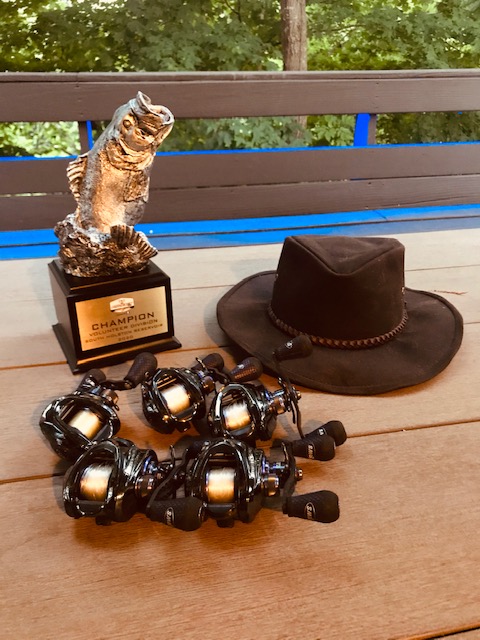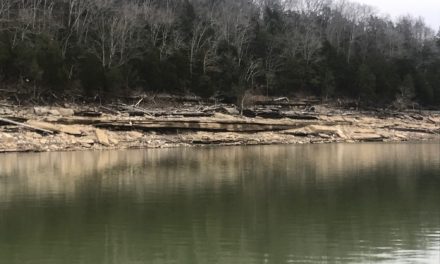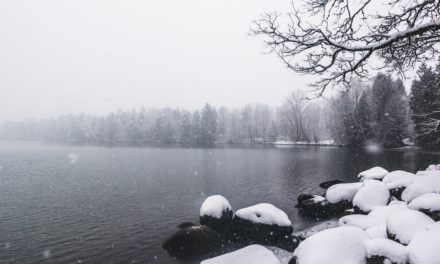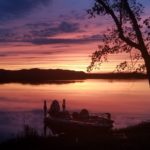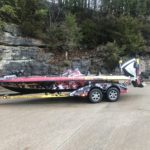I have the trophy, and the check, but it hasn’t really sunk in. I keep waiting for it to click even while I am preparing for Dale Hollow.
But there is no question that Saturday was the biggest day of my Fishing career. South Holston was my 7th professional tournament, and my first win as a sponsored angler. But I will be completely honest, before Saturday I was really trapped in that terrible thought of what would I do if I never win. I quit a crazy successful career to do this. The money I left one the table would make a financially minded individual weep. This is really a follow your dreams story unfolding. No question. And the thought of failing has plagued me from the start. To win hands down, and by a full pound against strong, accomplished anglers was a critical step that I needed to take towards next year, which is the Toyota Series and BassMaster Opens. As I have stated, if you can’t win in the southern reservoirs, you can’t win national tours. Period. I believe wholeheartedly that you have to be able to compete on the varied southern reservoirs against anglers who are strong anywhere, but in their home lakes, they are something more. I moved to Kentucky, to the meanest, most cruel body of water of them all to learn the art of reservoir bass fishing. Saturday was a big affirmation that this decision, and taking the time to develop was the correct strategy. This is the part where I thank my sponsors, Lew’s and Strike King for offering me such a great sponsorship even after I told them I needed 2020 to develop in the reservoir impoundments. They took a chance on sponsoring me when I made it clear that I needed further development. I won with Lew’s reels and rods in hand, and I threw Strike King lures, and that, along with some strategic planning, is all I needed.
You know, when you say to the wife, I am going to take first or last tomorrow, I wonder if you really believe that first is a reality, or if you are making conversation. But to explain where I was with that statement, we have to go back to practice on Thursday. Per my practice regimen, I arrived at the dock at 5 am ready to fish with a full tank of gas, packed lunch, and roughly 20 rods on the deck. Anytime you see me with more than say 5 rods, it means that there are a lot of patterns in play, or I am not sure what I want to do in terms of strategy. In this case it was the latter. I had a real quandary in the back of my mind. It surrounded the reality of South Holston in late may.
Now for the record, South Holston embodies all the great aspects of Tennessee fishing. It is clean, truly picturesque, has a large population of mean spirited bass, and is frequented by a group of great people. The hospitality of Bristol Tennessee is something to be proud of, and I truly enjoyed my time there. However, on Saturdays, it seems that most of the resident population is on the lake driving boats large and small, in every direction, concurrently. The only analogy I can provide is the lake scene from CaddyShack, where the water is complete pandemonium. Not exactly the quiet waters conducive to fishing.
And there is no escape.
South Holston is not a large impoundment. At 7500 acres, it is big enough to offer diversity, but unlike my home here at Lake Cumberland (65k acres), it is not big enough to escape the traffic on a beautiful Saturday in late May. My problem on Thursday was dealing with the reality that because of Covid, we had been delayed, and a tournament that was supposed to be on March 28, was now going off on May 30. This was a critical issue because a pre-spawn tournament early in the year would have been largely centered around secondary points, ranging to the backs of the creeks. Even though the weather in later march was pretty good, the water temperature would have prevented swimming and wakeboarding, thereby eliminating the crazy traffic on the lake. Sure there would have been some boats, but like many lakes in march, pleasure boaters would likely have kept to the main lake with the anglers in the creeks. Each to their own. This would have been fine because the main lake is not particularly active for fishing when the pattern is in full pre-spawn. Not the case with May. In May, we as anglers play a different game, which has two variants. First, wake up at 4 am, fish like you are on fire until about 9 am, and avoid the first of the pleasure craft on the way back to the dock, on the trailer and home before 10. The second variant is put the boat in at 6 pm, avoid the pleasure boaters on the way out, fish in peace until midnight, and hopefully don’t lose your lower unit to floating timber while coming back in pitch darkness.
Fishing tournaments represent the magical option 3. Which is fish on the weekend from 6:30 til the mid afternoon. That means for at least 4-5 hours, you are fishing while everyone else is trying to jump the wake or tying their boats together over beers in the location you discovered held the perfect structure for bass. There is nowhere on this lake that is not disrupted by weekend boating.
Now I believe this was absolutely key to understanding South Holston and developing my strategy. I opened up on Thursday with two suppositions.
- The main lake fish were not just bigger than their creek counterparts, they were significantly bigger.
- The fish were not in the summer pattern per se, but rather in a post spawn period of relative inactivity.
Now I checked these theories thoroughly during practice on Thursday. First I wanted to be sure that the main lake points and creek secondary points weren’t hosting fish that were in transition to the main lake. The creeks held fish, active fish in fact, but they were smaller than what I was targeting and the bite wasn’t consistent. I also checked the main lake flats, humps, points, pretty much anywhere a summer bass would be located and realized the same thing, fish were there, bigger fish, but the bite again was inconsistent. These were the proverbial scattered fish.
I came to the conclusion that the bite was tough, and the pattern obscure. Because the summer pattern, and hence the traditional deep structure fishing was premature, the traditional alternative would be to move into the mid to upper creeks and then take advantage of the slightly lesser traffic to continue putting fish in the boat through a difficult day.
But what about the anti-pattern? I have discussed this extensively and I believe in this concept without question. Thus began the reasoning that led to my strategy.
Consider the water temperature. 73 degrees on the main lake. A bit higher in the creeks. But I noticed something in the creeks that got me thinking of a possible strategy. The bass, which located on the laydowns, in the submerged timber, etc. were present. But they were active in the flooded bushes and trees along the shoreline. You could here them exploding in what I initially perceived to be inaccessible underbrush. The question was what were they exploding on? Put 2 and 2 together. 73 degree post spawn conditions and bass going nuts in tough to reach cover.
Shad spawn.
Now, whenever you hear anyone talk about the shad spawn, you will hear them relate that the shad proceed up the creeks when the water temperature reaches 70 degrees and spawn in the darkness typically during the full moon phase. But in this particular case, some variables have definitely been left out.
First there is the crazy weather we have had this spring. Here on Cumberland, the spawn got delayed over and over again because of cold fronts, warm ups, and dramatic cold fronts forcing the bass on and off the beds. For the largemouths it was rather predictable but it completely confused the smallmouth bite. In fact, many smallmouth either frenetically spawned, or did not spawn at all. Some, however, spawned in locations that might be considered less common than other years. lake pockets and main lake ledges for example.
So I am standing on my boat hatching a crazy plan without even realizing it. This is truly a matter of building assumption on top of assumption based really on a minimum of actual information. But more than anything, it is a practical application of the anti-pattern approach to bass fishing.
After the fact, I think this is what professional fishing actually is all about. So here is where I ended up on Thursday evening.
- I was going smallmouth fishing in the anti- pattern.
- The big smallmouth, the ones I am targeting are either back on the main lake from the spawn, or never left the main lake at all.
- The shad are spawning, and many of them are in the creeks, but some will spawn in main lake pockets.
- The smallmouth that never left the main lake likely spawned in those same pockets, or in the vicinity.
- Staying far away from creek entrances ensures true main lake smallmouth, hence bigger quarry.
- The smallmouth are relatively inactive, but are staged in the vicinity of those pockets, otherwise they would have to travel for food.
- During the late night, and the early morning, the smallmouth will move into the main lake pockets and crush the shad, returning to inactivity by day.
- The main lake will be unfishable by 10 am on tournament day due to pleasure boaters who will shut off any remaining bite with noise and traffic.
These suppositions would make a logician go mad as there is nothing that holds up here to logical scrutiny. But in fishing terms, it was iron clad. So after pouring over the maps on Thursday night, I was ready to go on Friday morning and I executed the plan perfectly, except for the part where I caught a lot of fish. Sure I caught fish, but I did not catch them fast enough in the early morning. Take this monster I caught off a lay down on the main lake.

This is a great fish, 4 pounds or so which is fantastic for Holston, but the problem is that I caught this fish at 1 pm off a long lay down where the bulk of the timber was in 30 feet of water. This is a classic solitary fish, and not any kind of shad pursuit. That same lay down would be shut off on Saturday and there weren’t enough of them to put together a good bag. So while it was great for a photo op, it wasn’t going to constitute a strategy.
The real problem lay in what happened at 7 am that morning. I found pockets with shad, and could hear the bass exploding in the back of the timber or flooded bushes, but it was inaccessible. I had seen this same thing the day before. I could not get the bait in, and if I did, getting the fish out would be just as difficult. On top of that, I know they could see the boat if I got too close, so flipping was not going to be an option.
I left the lake, drove back to my fantastic cabin that I rented, and sat on the porch considering my problem. I knew where the fish would be, but I couldn’t get close to them, and accessing lanes to cast would be tough. Even if I did, the casts themselves would have to be at least 30 feet, with the last 10+ feet of skip to get under and around the low hanging branches and cover.
Here is where my complicated plan went right off the deep end. I accepted right then and there that the morning was going to be crazy.
I came to the conclusion that I am either a professional or not.
Then I began setting up reel after reel exactly the same. And what I had in mind in retrospect was really an all or nothing gambit. Which brings me to the conversation with my wife when I told her I was going to take first or last.
Now when you turn pro, something comes over you and makes you start believing that you are in fact a pro. For me, it translated to taking practice very seriously. Many people consider fishing to be 90% mental, and 10% physical, this is wholly inaccurate.
Its 100% mental, and 100% physical, like any other professional sport. The two go together or not at all.
For years, I have practiced at least 20 hours a week on just casting technique. And because I have dealt with concurrent years of flooding on Lake Cumberland, skip casting, and flip skipping long distances have been a huge part of that time investment.
If you want to be a pro, it begins with the resolution that there is no inaccessible.
I set up 5 Lew’s Pro TI reels with 12 pound test fluorocarbon line, I put 3 of them on 7′ Lew’s custom speed stick rods in medium power. The other 2 I put on 6’10” Lew’s Pro TI rods in medium heavy power. On all five I put Strike King tour grade swim jigs in chartreuse sexy shad with a rage swimmer trailer in pearl flash. My sizes ranged from 1/4 to 3/8 in the jig, and 3.25″-3.75″ in the swimmers. The lighter lures were tough to throw but I had practiced for that by compensating with a longer lead length from the rod and controlling my speed during the cast. The heavier lures were easier to cast but caused more disruption during the skip. That was a good or bad thing depending on the situation. All in all, I was ready to execute my plan.
I was going in after those ‘inaccessible’ bass. Which meant I needed to move fast because I had to get it done before the sun changed morning to day. My whole tournament would be fished before 8 am. One way or another, when day broke in earnest, the shad bite would turn off, and I would find myself quickly in the midst of a pleasure boat regatta making any pursuit of bass in the transitional areas a useless endeavor. And then I found out I was boat #56.
Welcome to professional fishing.
The morning of the tournament I watched 55 boats take off directly headed to my carefully chosen location. I even got passed by a few other boats because of my conscientious driving. As I entered the main lake, I passed a series of points and turned north towards a group of western facing pockets and realized that I was traveling in calm waters.
Completely alone.
No one selected this area, not a single boat was there. I can’t describe my surprise. For a moment I began to wonder if the entire field knew something I didn’t and I was in for a prolific beating. Fishing is a roller coaster mentally.
But I was committed to the anti-pattern.
Arriving in the first pocket, I was up and fishing, the race to catch a limit was on. Within minutes, I had my first big strike and began hauling an impressive smallmouth towards the boat, only to be mortified as he slipped the hook not a foot from the boat.
Minutes later, I got a second strike underneath a flooded tree and landed my first fish, a 16 inch smallmouth. This was followed by a third strike and another fish throwing the bait.
It went on and on. I went through reel after reel as there was no way I could brake them trying to cast through so much cover with so little clearance from the water. Even with the brakes at maximum and thumbing the spool, a quick strike into a branch or other obstruction either left me without a lure or with an impaired reel. I just dropped it to the deck and picked up another rod.
Skip, skip, cast, skip. Fish on, fish off. Reel cashiered, new reel. some more skipping, check the sun, running out of time.
I can’t even describe to you how difficult the casting requirements for this fish really were. These were long casts under cover another 5-10 feet. At times they were into foot wide pockets, the strikes were either tumultuous or taps, and the hooksets were often low and to the side in order to prevent getting hung up in the foliage leading to awkwardly hooked fish that could shake the lure.
I put 5 in the live well, lost 6, went through 5 reels, and a little after 8 am the bite completely shut off as the sun broke through the clouds and the morning began to significantly brighten. At 9, I accepted that it was over and took an assessment of the situation.
I had about 15 pounds or so. Which at the time I did not believe would be in contention to win. So I set my sights to finding a kicker fish while the wakeboarders jumped into the water and the chaos of Saturday on South Holston began. For 6 hours I fished feverishly thinking all I needed was just a single significant upgrade. But no fish I caught was qualified to replace what I had in the well.
After 3 pm, I made my way back to the weigh in thinking that I might be in the money, but there was another thought in my mind as well. I was shocked how terrible the bite was after the early morning. It was prolifically bad. I even checked a creek to see if I could pick up a decent largemouth and try to give my co-angler the opportunity to increase her count. Even there, nothing.
What if the bite was as bad for everyone else, and they didn’t capitalize on the shad spawn strategy? What if there was no other solution for this particular day, in this particular tournament. What if I nailed it in my planning session? Could 15 pounds really win. Could the anti-pattern really be a viable concept?
Not a chance.
That seriously is what I came to on the way back. So I settled into my seat and focused on the slalom between the careening pontoons, wake boats, and the occasional frazzled fishing boats just trying to get back to the dock. At 3:30, we were back to the weigh in where I found out that 13-14 was in the lead.
I knew I had 13-14 beat. Putting my fish on the scale, I knew I was coming out on top, but the question was by how much. It ended up being 14-14, which is close to where I figured I would be, but at the time I would have vastly preferred to be erring on the up side rather than the down. 14-14 didn’t feel like a number that would hold up.
And so began the process of watching boaters come in with full bags and dreading the total let down of hearing a higher number while at the same time accepting the fact that it was going to happen.
But then it didn’t happen.
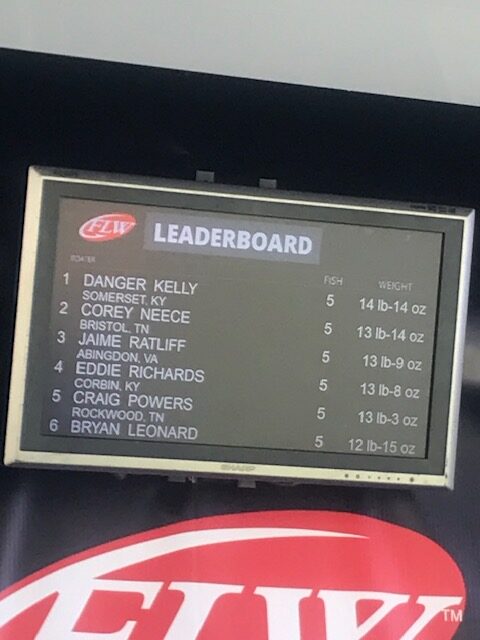
This is the leaderboard after the last fish was weighed. I just stared for a minute. I was so wrapped up in this crazy strategy and the rush to catch just one more kicker fish, then accepting my fate of coming close, to taking the lead, to expecting to lose the lead, and suddenly I was the winner.
I am still there. I am stuck, I won, but I am still just stunned maybe, surprised sure, but more than anything else, I am questioning perhaps a reality in all of this. I left my job for something better. But the world seems to be full of people who win it all at 21. This gives so many of us the idea that if you aren’t a champion out of the gate that you never will be. Its a terrible ageism, and I believe other people who are on the backside of life, proverbially speaking, have sensed this though I don’t believe it is even intentionally related. Maybe its because responsibility is real, and when you are older it is difficult to make changes. Everyone tells you, you make lots of money, you are successful, hold the course, don’t take a chance. Don’t wake up at nearly 50 and try to remake your life.
When you are older, dreams get more expensive, because if you fail, you may not have the time to change course, and you question whether you could ever go back.
I always believed I could win, but it was that sort of belief that you hold in a dream state because you wonder, could something that great really happen to me.
I still can’t feel this win. I never won anything before, so I don’t even know what it is supposed to feel like. But I keep having this thought that is dwelling in the back of my mind…
I think Saturday was the best day of my life.

